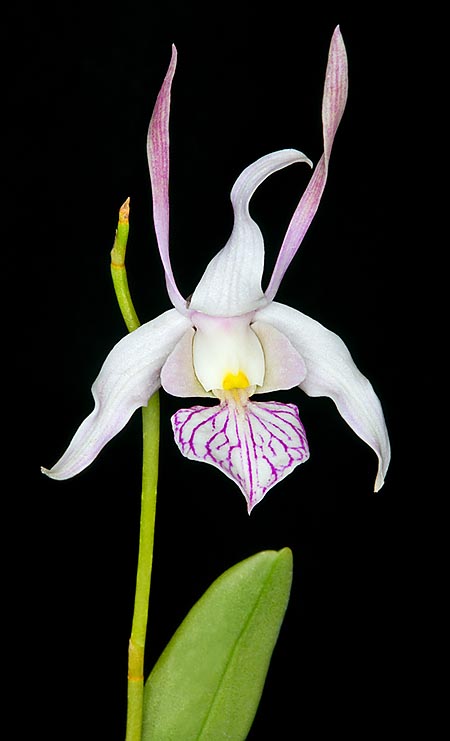Family : Orchidaceae

Text © Pietro Puccio

English translation by Mario Beltramini

Dendrobium leporinum, epiphyte in the Moluccas and New Guinea humid forests at low altitudes, is little known in cultivation © Giuseppe Mazza
The name of the genus is the combination of the Greek substantives “δένδρον” (dendron) = tree and “βίος” (bios) = life, with reference to the numerous species of the genus living on the trees; the name of the species is the Latin adjective “leporinus, a, um” = of the hare, with probable reference to the petals resembling ears of hare.
The Dendrobium leporinum J.J.Sm. (1909) is an epiphytic species with fairly thin pseudobulbs, 0,5-1,2 m long, with alternate, distichous, oblong-lanceolate, up to about 7 cm long and 2 cm broad, coriaceous, intense green leaves.
More or less erect racemose inflorescences from the upper nodes carrying flowers of about 6 cm of diameter. Ovate-triangular, about 3 cm long, sepals, undulated with curved apex white or white suffused of violet apex, the lateral sepals, merged at the base of the column, form a sort of spur (mentum). Linear petals with pointed apex, erect and twisted, about 4 cm long, of light violet or purple colour, trilobed labellum, about 3 cm long, with erect lateral lobes of white or greenish white suffused of violet at the margins colour and cordate median lobe with white pointed apex run by violet striations.
It reproduces by seed, in vitro, and division, to be done at the vegetative restart, with each section provided of at least 3-4 pseudobulbs.
Species rare in cultivation very similar to the Dendrobium stratiotes, from which differs for the colour and the structure of the labellum, with long-lasting, 6-8 weeks, ornamental flowers, requires high luminosity and medium-high temperatures, with lowest winter ones not under the 15 °C, high humidity, 60-80%, and good and constant ventilation. Waterings must be regular and abundant during the growth of the pseudobulbs, allowing to partially dry up before giving water again, more spaced during the winter till the vegetative restart.
For the waterings and nebulisations, is to be used rain water, from reverse osmosis or demineralised; the fertilizations, duly distributed in way to avoid salts accumulation, are to be done during the vegetative period preferably with hydrosoluble with low nitrogen content products, with microelements, at ¼ of the dosage suggested on the package.
It can be mounted on bark, trunks, rafts of cork or of arborescent ferns roots, or cultivated in pots or baskets with particularly draining and aerated compost, which may be formed by medium sliced bark and charcoal fragments with possible addition of inerts for improving the drainage. Transplants and repottings are to be done when strictly necessary by the vegetative restart, signalled by the appearance of the new roots.
The species is reported in the appendix II of the CITES (species whose trade is internationally ruled).
Synonyms: Ceratobium leporinum (J.J.Sm.) M.A.Clem. & D.L.Jones (2002).
→ For general notions about ORCHIDACEAE please click here.
